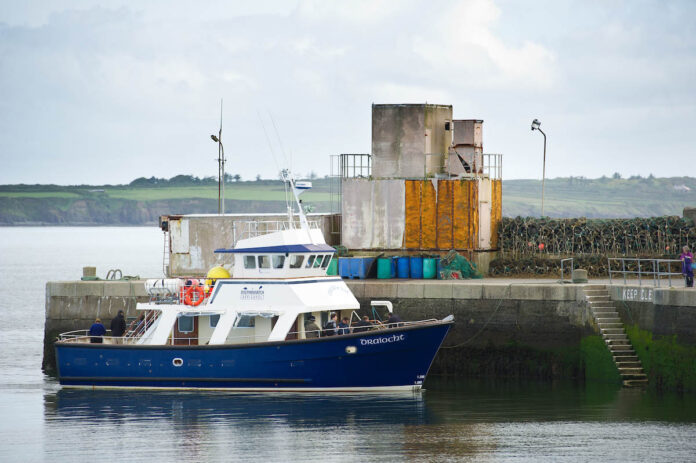GRAVE concerns about the possible impact on dolphins from the expansion of a controversial Bauxite Residue Disposal Area (BRDA) for the largest alumina plant in Europe were outlined to An Bord Pleanála recently.
An Bord Pleanála has given Rusal Aughinish Alumina Limited (AAL) the green light to deposit an extra eight million m3 of bauxite residue in total at its plant, despite trenchant opposition from Futureproof Clare, local farmers, Environmental Trust Ireland and environmental groups.
This decision will allow the Russian-owned company to carry out a major expansion of its Bauxite Residue Disposal Area (BRDA), extending the life of the plant for an extra nine years up to 2039.
In a submission to the appeals’ board on behalf of Dolphin Watch, Mary Kate Bolger, who has a qualification in zoology and marine biology specialising in bottlenose dolphins, outlined the creatures play a vital role in the eco-system by balancing populations of predatory fish and squid thereby protecting the entire eco-system of the estuary.
The Shannon Estuary is the home of a resident group of about 130 to 150 bottlenose dolphins, which are protected under Annex II of the EU Habitats Directive. They have been present in the estuary for a long time.
Ms Bolger claimed long-term exposure to bauxite residue is well known to have toxic impacts on the internal organs of humans and animals.
“The dolphins in the Shannon Estuary are exposed to this residue from the insufficient lining in the BRDA and from fugitive dust blown from the red mud pond.
“The residue could also impact on fish populations in the estuary on which the dolphins predate.
“Skin lesions in dolphins occur in response to environmental stressors. Skin lesions are occurring on the dolphins in the Shannon Estuary. While the exact cause of this is not known, it is apparent that the overall health is declining.”
On October 4 2010, she recalled a BRDA dam at the Ajka alumina plant in Hungary failed, releasing approximately 1,000,000 tonnes of bauxite residue resulting in the deaths of 10 people and leading to severe chemical burns among the local population.
If such an event took place at Aughinish, she claimed this would severely affect the birth-rate of livestock and could cause the collapse of an entire ecosystem.
“Noise pollution from rock blasting could also have an unacceptable impact on dolphins as these creatures rely heavily on echolocation to navigate and communicate. The dolphins are already exposed to noise from shipping and other marine traffic within the estuary and it is noted that noise propagates faster through water.
“The bathymetry of the Shannon Estuary will result in sound being reverberated off the seabed and will be amplified, causing extreme stress and further physiological damage to the dolphins which could be detrimental to their survival.
“Nature tourism is one of the fastest growing industries in the world and dolphin watch Carrigaholt has been operating since 1992 and has attracted many international and Irish tourists.
“Even without the Aughinish Alumina plant there are likely significant health and social problems for dolphins in the Shannon Estuary. Losing the Dolphin population could cause a great environmental and economic toll,” she stated.
However, in a response on behalf of the applicant by Tom Phillips and Associates, the planning consultants noted the NIS submitted notes that bottlenose dolphins are largely concentrated near
the mouth of the Shannon Estuary and are infrequently present upstream of Glin, which is 15 kilometres from the subject site.
“Any claims that exposure to bauxite residue may be harmful to dolphins are strongly disputed. It is noted that the observation primarily attributes any impact on dolphin health not directly to the operations of AAL but rather to the general operation of industry in general.
“A recent publication from Rogan et al (2018) has found that the dolphin population of the Shannon Estuary which has been studied intensively for almost 30 years has remained relatively stable with a marginal increase of overall abundance.
“The NIS is accompanied by a conceptual site model prepared by RSK Environmental Limited. It considered the available scientific evidence to evaluate potential pathways that could connect the subject site with the immediate marine and terrestrial environments. Sampling data indicated that there are no pathways being realised that may impact on metal concentrations within the sediment in the immediate marine environment.
“Sediment concentrations are in line with typical background concentrations for the marine environment. Hence, it is concluded that there is no pathway for heavy metals and no evidence that heavy metal concentrations are elevated.
“The data also indicates that there is no pathway between the subject site and designated areas of intertidal estuary for feeding birds,” the consultants argued.
In relation to skin lesions on the dorsal fins of the bottlenose dolphins, the response stated that these have been observed in populations of dolphins from all over the world. A number of theories have been put forward as to why this is happening. However, the consultants stated there is nothing unique in the Shannon population showing skin lesions.
They also noted that a marine mammal risk assessment on potential impacts of blasting concluded that there was no risk of likely significant effects on the dolphin species arising from noise and vibration impacts.
“Noise and vibration levels from the blast will attenuate quickly and the nearest potential bottlenose dolphin habitat is located over 1.3 kilometres from the borrow pit.”
East Clare correspondent, Dan Danaher is a journalism graduate of Rathmines and UL. He has won numerous awards for special investigations on health, justice, environment, and reports on news, agriculture, disability, mental health and community.




